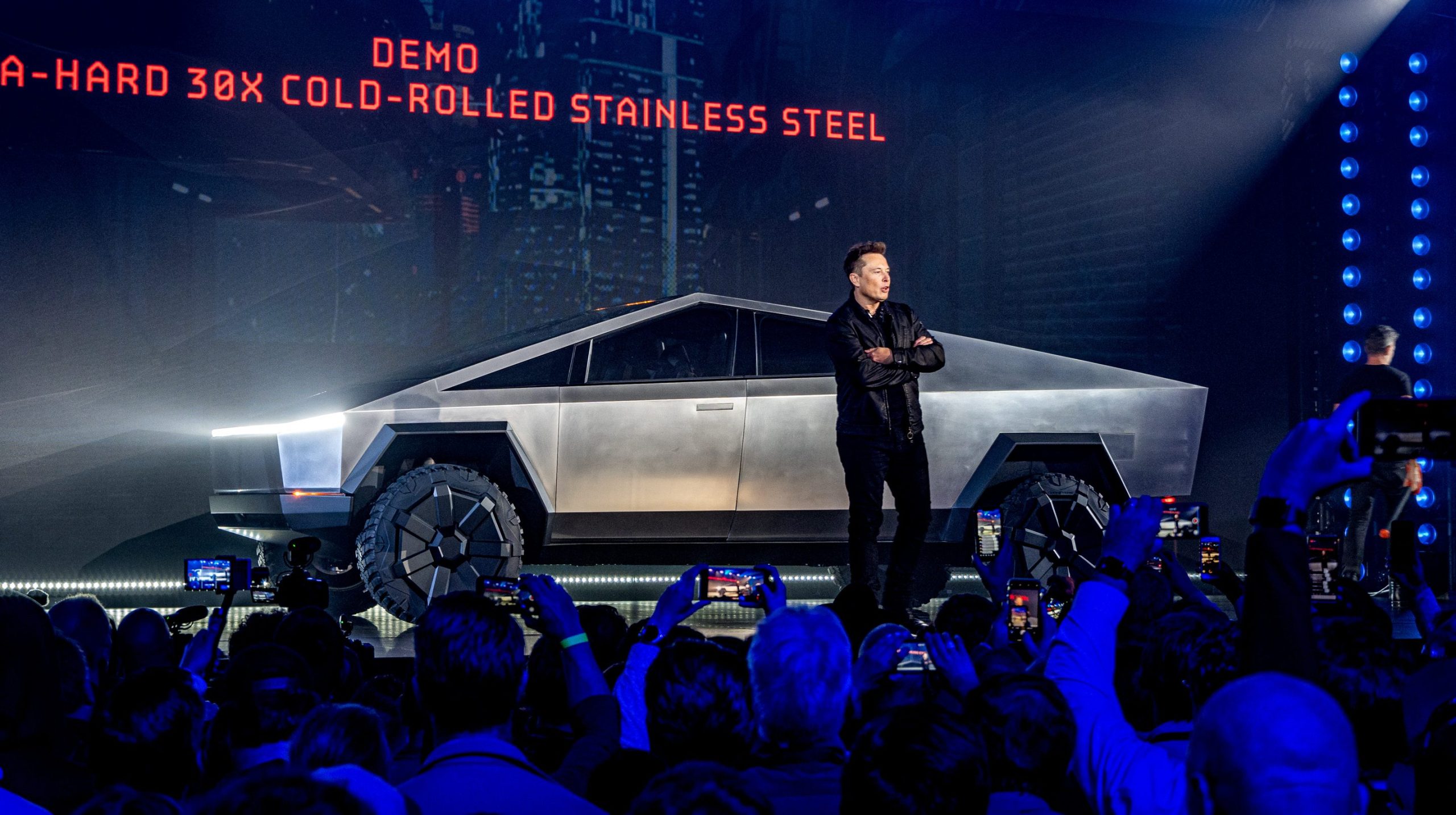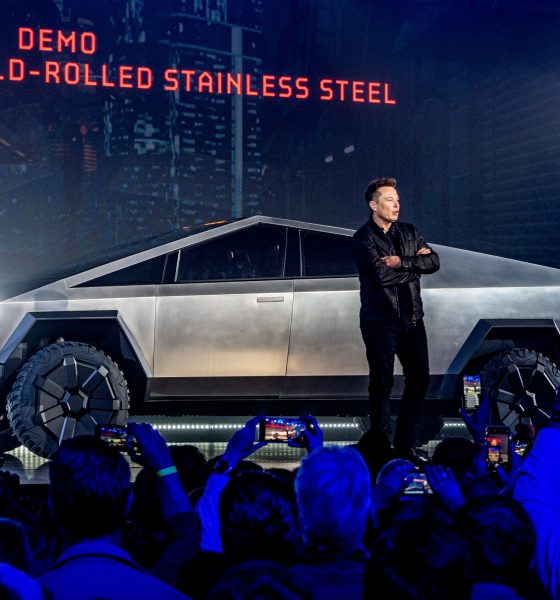

News
Elon Musk hints at more compact Tesla Cybertruck with same space and utility
Tesla CEO Elon Musk has hinted that the Cybertruck might have more compact dimensions when it rolls out in 2021. The idea came after a Tesla owner-enthusiast’s video showed that the Cybertruck may not fit in a normal, residential-sized garage. Based on the Tesla CEO’s recent tweets, it appears that Tesla may be able to shave off a few inches off the Cybertruck’s rather bulky body without compromising anything in terms of utility and looks.
Musk’s comments came after Model 3 owner Tesla Raj posted a video featuring an augmented reality app estimating how the Cybertruck would look like in a target area. When Raj used the app to see if it would fit in his garage, he found the 231.8 inch-long Cybertruck was just a bi too long for the space in his home.
Musk responded to these findings, stating that the Cybertruck could receive a design revision that would make the car a bit easier to fit in a traditional American garage. “We can prob reduce width by an inch & maybe reduce length by 6+ inches without losing on utility or aesthetics. Min height is below 75 inches when air suspension set to low. Will post exact number soon,” Musk said.
We can prob reduce width by an inch & maybe reduce length by 6+ inches without losing on utility or esthetics. Min height is below 75 inches when air suspension set to low. Will post exact number soon.
— Elon Musk (@elonmusk) December 7, 2019
Based on Musk’s tweet, the more compact Cybertruck would have a width of 78.8 inches instead of the original 79.8 inches, and its length will be reduced to to 225.7 inches from 231.7 inches. This should make the Cybertruck easier to fit even in 20×20 garages. Parking the vehicle and maneuvering the massive all-electric machine would likely be easier as well. What’s more remarkable is the Tesla CEO explained that these reductions won’t cause any compromises with the vehicle’s stellar utility and iconic aesthetics. Musk has also promised no loss in cargo capacity or interior space with the vehicle’s more compact size.
After providing some updates on the Cybertruck’s dimensions, Musk also received a question about the approximate size of the “smaller” Cybertruck that he has hinted at in the past. Musk stated that such a vehicle would likely require a full redesign, though he noted that the truck’s dimensions will “probably (be) ~73 inches (height) or ~185 cm width”. This is compared to its 75-inch height when the vehicle’s adaptive suspension is fully-lowered, and its 202.7 cm width in its current build. Such a vehicle will still be significantly smaller to the Cybertruck, even considering Elon Musk’s more compact projections.
That will require a full redesign, but probably ~73 inches or ~185 cm width
— Elon Musk (@elonmusk) December 7, 2019
That being said, it seems that a significant portion of the Tesla community prefers the Cybertruck in its current, massive form. A few followers of Musk’s Twitter account even stated that the Cybertruck will never need to be parked in a garage anyway, as its stainless steel design is “completely impervious to weather” and that its solar-equipped tonneau cover begs to be exposed to the sun at all times. Musk, for his part, appears to be weighing both sides when it comes to the Cybertruck’s size.
A new Cybertruck design that that is more compact could prove to be beneficial for Tesla in the long run. While the company has already received at least a quarter-of-a-million pre-orders for the original design for the truck, a smaller version may entice those who were worried about the size of the truck to pull the trigger and buy Tesla’s first pickup. The smaller design will appeal to those who are interested in parking the all-electric powerhouse in their garage, or at least those who want a pickup but prefer a smaller design that would be easier to drive through narrow streets and easier to park in busy lots.

News
Tesla FSD fleet is nearing 7 billion total miles, including 2.5 billion city miles
As can be seen on Tesla’s official FSD webpage, vehicles equipped with the system have now navigated over 6.99 billion miles.

Tesla’s Full Self-Driving (Supervised) fleet is closing in on almost 7 billion total miles driven, as per data posted by the company on its official FSD webpage.
These figures hint at the massive scale of data fueling Tesla’s rapid FSD improvements, which have been quite notable as of late.
FSD mileage milestones
As can be seen on Tesla’s official FSD webpage, vehicles equipped with the system have now navigated over 6.99 billion miles. Tesla owner and avid FSD tester Whole Mars Catalog also shared a screenshot indicating that from the nearly 7 billion miles traveled by the FSD fleet, more than 2.5 billion miles were driven inside cities.
City miles are particularly valuable for complex urban scenarios like unprotected turns, pedestrian interactions, and traffic lights. This is also the difference-maker for FSD, as only complex solutions, such as Waymo’s self-driving taxis, operate similarly on inner-city streets. And even then, incidents such as the San Francisco blackouts have proven challenging for sensor-rich vehicles like Waymos.
Tesla’s data edge
Tesla has a number of advantages in the autonomous vehicle sector, one of which is the size of its fleet and the number of vehicles training FSD on real-world roads. Tesla’s nearly 7 billion FSD miles then allow the company to roll out updates that make its vehicles behave like they are being driven by experienced drivers, even if they are operating on their own.
So notable are Tesla’s improvements to FSD that NVIDIA Director of Robotics Jim Fan, after experiencing FSD v14, noted that the system is the first AI that passes what he described as a “Physical Turing Test.”
“Despite knowing exactly how robot learning works, I still find it magical watching the steering wheel turn by itself. First it feels surreal, next it becomes routine. Then, like the smartphone, taking it away actively hurts. This is how humanity gets rewired and glued to god-like technologies,” Fan wrote in a post on X.
News
Tesla starts showing how FSD will change lives in Europe
Local officials tested the system on narrow country roads and were impressed by FSD’s smooth, human-like driving, with some calling the service a game-changer for everyday life in areas that are far from urban centers.

Tesla has launched Europe’s first public shuttle service using Full Self-Driving (Supervised) in the rural Eifelkreis Bitburg-Prüm region of Germany, demonstrating how the technology can restore independence and mobility for people who struggle with limited transport options.
Local officials tested the system on narrow country roads and were impressed by FSD’s smooth, human-like driving, with some calling the service a game-changer for everyday life in areas that are far from urban centers.
Officials see real impact on rural residents
Arzfeld Mayor Johannes Kuhl and District Administrator Andreas Kruppert personally tested the Tesla shuttle service. This allowed them to see just how well FSD navigated winding lanes and rural roads confidently. Kruppert said, “Autonomous driving sounds like science fiction to many, but we simply see here that it works totally well in rural regions too.” Kuhl, for his part, also noted that FSD “feels like a very experienced driver.”
The pilot complements the area’s “Citizen Bus” program, which provides on-demand rides for elderly residents who can no longer drive themselves. Tesla Europe shared a video of a demonstration of the service, highlighting how FSD gives people their freedom back, even in places where public transport is not as prevalent.
What the Ministry for Economic Affairs and Transport says
Rhineland-Palatinate’s Minister Daniela Schmitt supported the project, praising the collaboration that made this “first of its kind in Europe” possible. As per the ministry, the rural rollout for the service shows FSD’s potential beyond major cities, and it delivers tangible benefits like grocery runs, doctor visits, and social connections for isolated residents.
“Reliable and flexible mobility is especially vital in rural areas. With the launch of a shuttle service using self-driving vehicles (FSD supervised) by Tesla in the Eifelkreis Bitburg-Prüm, an innovative pilot project is now getting underway that complements local community bus services. It is the first project of its kind in Europe.
“The result is a real gain for rural mobility: greater accessibility, more flexibility and tangible benefits for everyday life. A strong signal for innovation, cooperation and future-oriented mobility beyond urban centers,” the ministry wrote in a LinkedIn post.
News
Tesla China quietly posts Robotaxi-related job listing
Tesla China is currently seeking a Low Voltage Electrical Engineer to work on circuit board design for the company’s autonomous vehicles.

Tesla has posted a new job listing in Shanghai explicitly tied to its Robotaxi program, fueling speculation that the company is preparing to launch its dedicated autonomous ride-hailing service in China.
As noted in the listing, Tesla China is currently seeking a Low Voltage Electrical Engineer to work on circuit board design for the company’s autonomous vehicles.
Robotaxi-specific role
The listing, which was shared on social media platform X by industry watcher @tslaming, suggested that Tesla China is looking to fill the role urgently. The job listing itself specifically mentions that the person hired for the role will be working on the Low Voltage Hardware team, which would design the circuit boards that would serve as the nervous system of the Robotaxi.
Key tasks for the role, as indicated in the job listing, include collaboration with PCB layout, firmware, mechanical, program management, and validation teams, among other responsibilities. The role is based in Shanghai.
China Robotaxi launch
China represents a massive potential market for robotaxis, with its dense urban centers and supportive policies in select cities. Tesla has limited permission to roll out FSD in the country, though despite this, its vehicles have been hailed as among the best in the market when it comes to autonomous features. So far, at least, it appears that China supports Tesla’s FSD and Robotaxi rollout.
This was hinted at in November, when Tesla brought the Cybercab to the 8th China International Import Expo (CIIE) in Shanghai, marking the first time that the autonomous two-seater was brought to the Asia-Pacific region. The vehicle, despite not having a release date in China, received a significant amount of interest among the event’s attendees.








